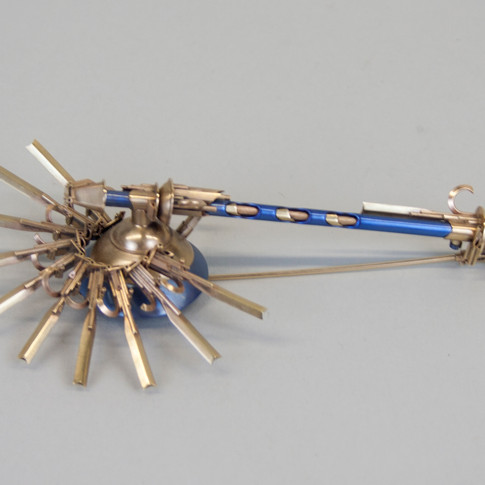
Richard Mawdsley is a well-known metalsmith and jeweler. He specializes in fabricated work using metal tubing and gemstones, and his work is heavily influenced by old machinery and mechanical parts. Mawdsley was chosen as the Metal Museum’s 1987 Master Metalsmith.
Richard Mawdsley was born in 1945 in Winfield, Kansas. While spending summers on his grandfather's farm, he came across many old pieces of rusty equipment, and these experiences later influenced the design and shape of many of his works. Mawdsley began metalsmithing largely by accident as an undergraduate student at Kansas State Teacher’s College (now Emporia State University). As a sophomore, he signed up for a jewelry course because all other art classes were full. Mawdsley went on to earn an MFA in Jewelry/Silversmithing from the University of Kansas in 1969.
After graduation, Mawdsley began teaching at Illinois State University, and in 1978, he relocated to Carbondale and began teaching in the metals program at Southern Illinois University School of Art and Design. He retired from SIU in 2004 as a Professor Emeritus. Throughout his career, Mawdsley has earned many honors and awards, including being elected to the American Craft Council’s College of Fellows in 1998 and serving as the President of the Society of North American Goldsmiths (SNAG) from 1987 to 1989.
Mawdsley’s work primarily features tubing of all shapes and sizes: triangular tubes, bent tubes, twisted tubes, fluted tubes, etc. He solders these tubes together to produce a variety of compositions. In addition to drawing inspiration from machinery, Mawdsley’s work features a variety of subject matters, including floral motifs, mythology and history. His jewelry pieces are primarily made from silver and gold, but in his later work, Mawdsley utilizes a Computer Numerical Control (CNC) milling machine to create vessels and other objects out of non-precious metals.
The Metal Museum currently has four of Richard Mawdsley’s works in our permanent collection: two brooches, one necklace, and a CNC vessel.
Oculi Rectus Superious #4 was made between 1982 and 1983. It features a half-sunburst made from 14K gold tubing with a central blue titanium rod. Looking like it was inspired by science fiction, Ray Gun was made in 1974 and features sterling silver tubing and jade balls. The fabrication of Ray Gun was published in Oppi Untracht's 1975 book Jewelry Concepts and Technology. Click here to read and see pictures detailing how the brooch was made.
In their book Makers: A History of American Studio Craft, Janet Koplos and Bruce Metcalf describe the necklace Medusa as having “a grinning mask [that] has sprouted a mass of writhing hair. The body resembles a machine as much as a human torso. Three pairs of ribs curl forward, enclosing no heart but revealing a spine. Armlike appendages dangle from her sides. At the base of the spine sits a domed piece of silver, which sprouts more restless hair.” (p. 335)
Untitled Standing Cup is number 16 of 75 identical vessels that Mawdsley made using a CNC machine in 2010. According to Mawdsley, this work is a modern rendition of ornamental turning, a method of forming ivory and wood vessels using a lathe. However, his CNC pieces are typically made from aluminum and brass.
To view more of Richard Mawdsley's work, check out his entry in our SNAG Slide Archive.








